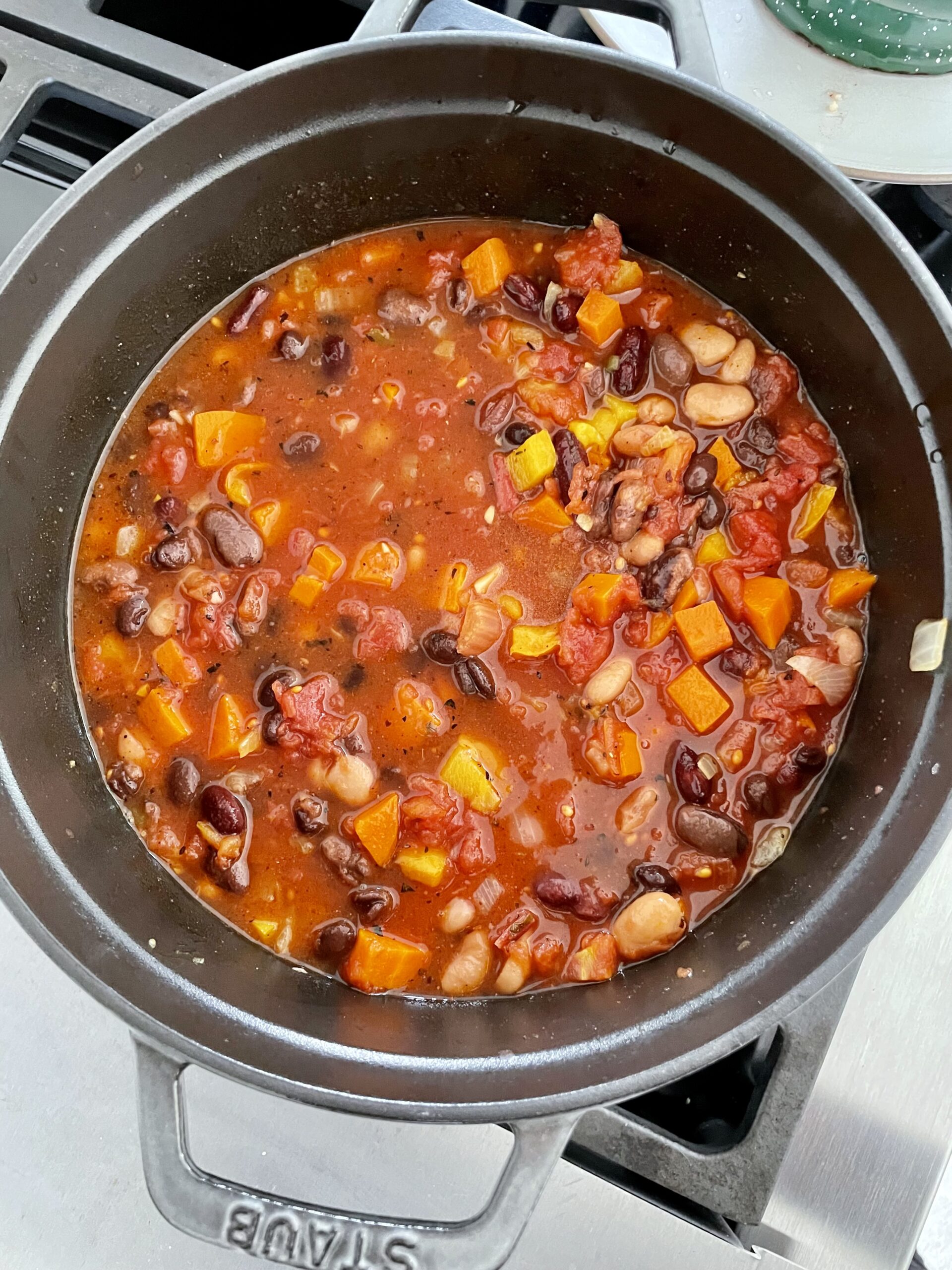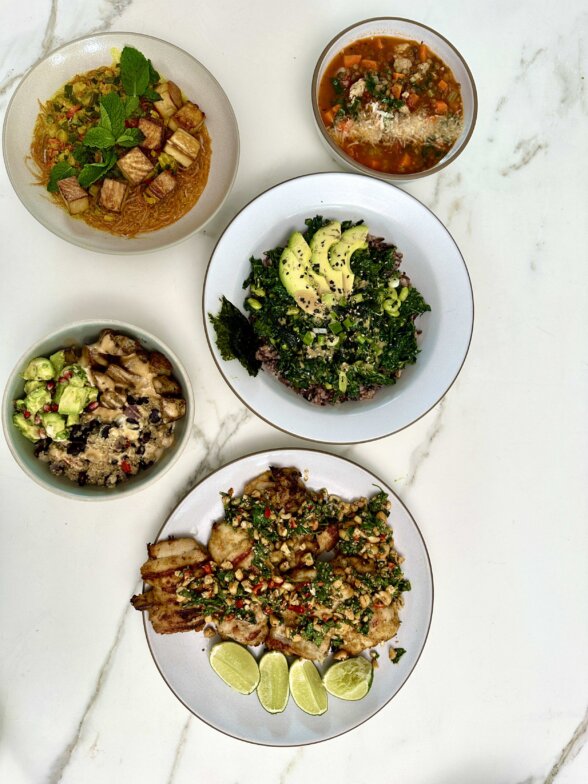
About Pamela
Learn about my story and my cooking classes

I have loved good food and enjoyed cooking for as long as I can remember. I bought my first cookbook in the second grade (I’ll never forget the title, “The Calling All Girls Party Cookbook!”), and found my way into the kitchen as much as I could. As a child, while other kids were at the playground, I was helping my father in the garden, watering plants and vines and watching miracles happen.
I come from a large Italian-American family with 28 first cousins (on one side of the family!) where sit-down holiday dinners for 85 people are the norm (how, you might ask – organization! But more on that later …). Some of my fondest memories are of simple family gatherings, both large and small, with long tables of bowls and platters piled high, the laughter of my cousins echoing and the comfort of tradition warming my soul.
The food I grew up with was never fancy, even though my mother always had a subscription to Gourmet. But I knew where the food came from and it was always real. It wasn’t until I was an adult that I learned more about the nourishing and healing power of food. And it wasn’t until I volunteered as a nutrition docent in an elementary school for Growing Great that it truly crystallized for me — our society has a big problem. I knew I had to do something, but was unsure of where to start.
At the same that I was contemplating how I could help people grasp the importance of proper nutrition and eating real food (hint: not processed or full of white flour), I was asked to teach a “healthful cooking class” for a group of young mothers. The business grew organically from that first group and I knew I had a message — and a new mission — in life.
My hope for this web site is that I can share what I have learned about what real food is and how to make it a part of your life. Let’s get back to basics so that we can nourish our families, and ourselves, and enjoy balance and health in our lives!
About My Cooking Classes

The motivation behind my cooking classes and this site is to encourage and inspire people to get back in the kitchen and cook real food. This has been a journey for me, not something that happened overnight and I wouldn’t expect anyone to overhaul his or her family’s pantry and regular diet in one fell swoop.
However, the Standard America Diet (literally S.A.D., for short) is not a sustainable one in many ways. The food that most of our population relies on is processed, refined, nutritionally lacking and works against our bodies’ natural processes. In addition, much of this food has a heavy environmental impact.
Unfortunately, our food has changed dramatically in the last hundred years, but our
but our physiological bodies have not. So all these so-called enriched or processed foods that we eat are laden with chemicals, preservatives and pesticides, and are disruptive to our bodies because they are unrecognizable.
There is a lot of confusing nutritional information out there and our country always loves a new fad, but there is nothing controversial about the fact that what we eat matters – food matters. The kitchen matters. I don’t think anyone can argue the fact that the Standard American Diet is making us sick.
What’s the answer?
I have a philosophy:
Eat Well…
Live Well…
Be Well…

We need to take steps toward a more whole foods-based diet with conscious thought to its impact on the environment. That means buying and preparing food that is natural to our bodies. Ideally, we are eating food that has been changed very little from the way it came into this world.
When I taught nutrition to elementary school children, I would demonstrate this concept with an apple, apple sauce, apple juice and apple-flavored cereal. Your whole food is the apple, complete with all its fiber, vitamins, mineral and anti-oxidants all in the perfect proportions. The apple sauce is missing the peel and the fiber and nutrients that go with it, so not a perfect “10” like the whole apple, but still a good food. The apple juice is farther
from the source. It has been refined (important things have been taken out of it) and is full of sugar.
Of course, the apple-flavored cereal does not resemble the whole food at all and does not provide anything good for your body like an apple would. This is a comparison that schoolchildren can grasp, and it is a perspective that can be applied to the foods you eat as well.
I have a 90/10 rule about food. 90% of the time I try to eat the best that I can and 10% of the time (which I save for the weekend), I eat whatever I feel like eating. It is helpful for many people to have some flexibility built into their diet so that they don’t feel guilty about enjoying a piece of birthday cake or stressed about eating a certain way all the time. It’s what we eat most of the time that really matters.

I do not know the right diet for you because we are all highly unique individuals and there is no “one size fits all” diet like most fads would have you believe. Your body will communicate with you when you are eating appropriately or not. I do think there are several basic dietary principles from which everyone can benefit:
- Eat as many whole foods as possible.
- Eat a wide variety of food.
- Eat as much organic food as you can afford or find.
- Cook as much as possible to control what goes into your food and to impart your loving energy into the food you serve.
- Eat seasonally.
- Shop locally.
- Listen to your body.
The recipes on this site are mostly from the classes I have taught over the last few years. These are recipes that are designed to be fairly easy, to use ingredients that can be found in a local supermarket and can be served to a whole family. I cook one meal every night. If my picky eater does not want to try the kale, I will be flexible by offering a few dried cherries to put on top or a squirt of ketchup, if that sounds good to him. If he still doesn’t want to try it, no problem.
But I will not be making an extra side dish for him and I will not do somersaults to make the kale seem more entertaining, and I will definitely not be doing origami with the kale and turning it into the shape of his teddy bear. If he wants nothing I have made for dinner, he can grab a handful of walnuts and blueberries and that’s it. I discourage anyone from making several meals to appease picky eater, or whom I call the “lowest common denominator.”
The best thing you can do for your kids is set a good example with your own eating habits and keep exposing them to whole foods. There is a lot of evidence supporting the notion that it takes children 10-15 times of being exposed to a new food before trying it. My son hovers in the 15 + range, but he is slowly coming around. I am not worried because my 18-year-old daughter was exactly the same way and now she eats everything. I know that if I gave into my daughter with buttered pasta and chicken tenders every night when she was younger, she would probably still be eating that way today.
I also think tastes for foods like veggies and whole grains develops over time. Again, don’t be discouraged if things don’t turn around overnight – Rome wasn’t built in a day, and neither will new eating habits. Stick with me and you will see positive changes!





